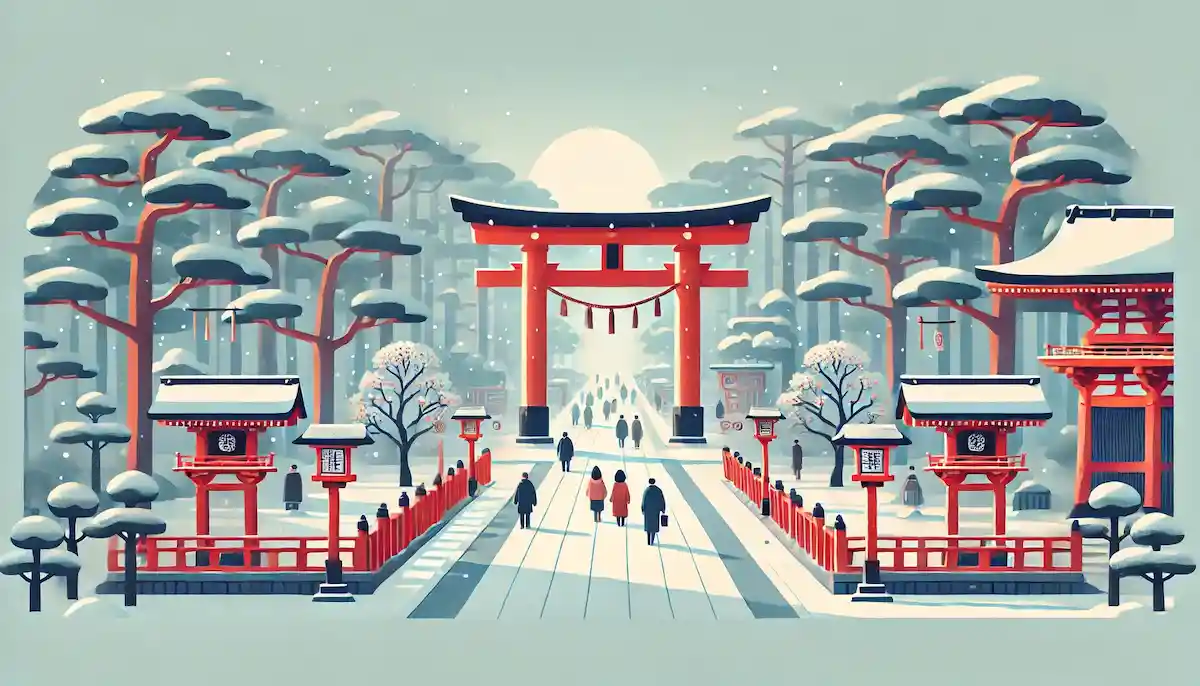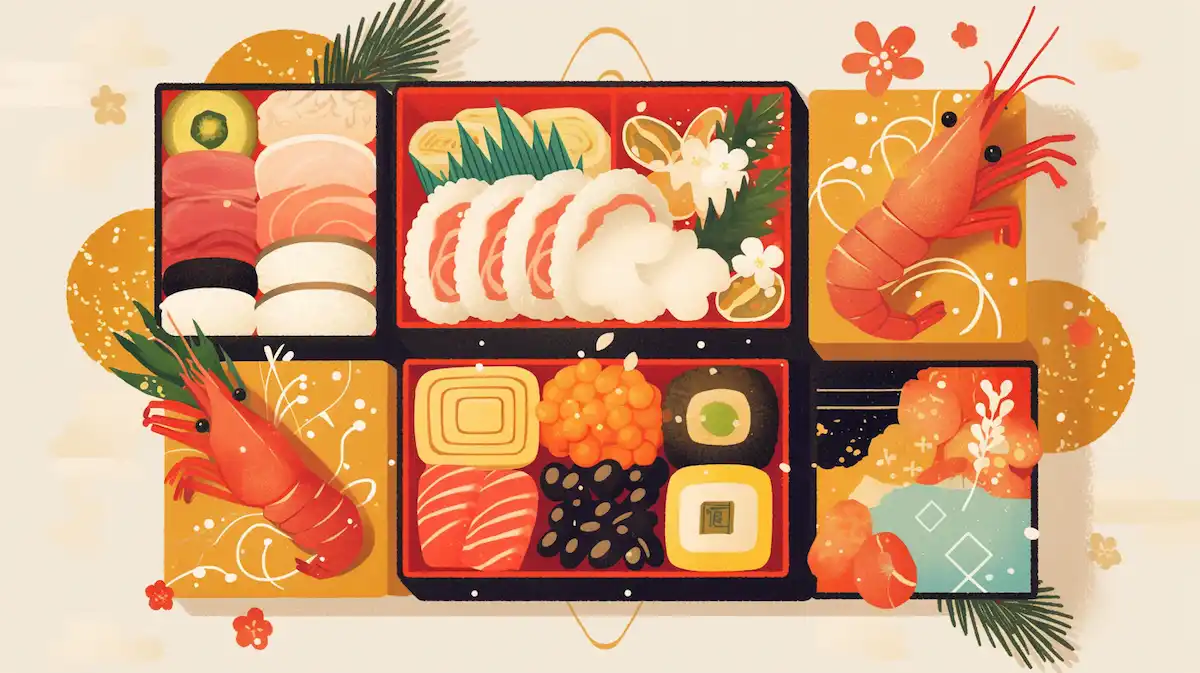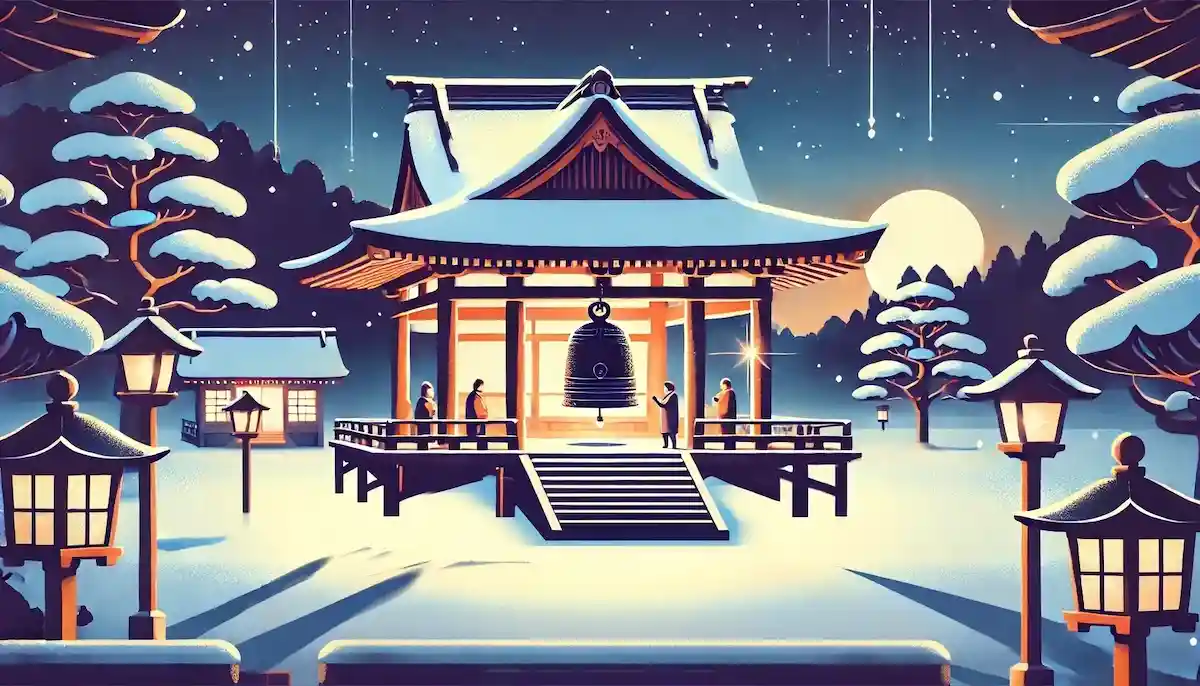元旦の行事・習慣などを英語で説明・紹介するための基本情報と、英会話に役立つ表現をシンプルでわかりやすい英語で紹介します。
英会話ダイアローグ・概要・10の質問を通して、元旦に関する英語表現を学びます。
記事の最後には、音声での深掘り解説もあります。リスニング力アップや、内容をさらに深く知りたい方におすすめです。
英語
英会話ダイアローグを読む前に知っておくと良い前提知識と情報です。
- 元旦の基本情報
- 1月1日は日本の最も重要な祝日の一つ、新しい年を迎える特別な日
- 新しい年を祝うとともに、健康や繁栄を祈る日とされている
- 元旦の主な習慣と行事
- 初日の出は、新年最初の日の出を見て、健康や幸運を祈る行事、山や海岸など、見晴らしの良い場所に人が集まる
- 初詣は、年の初めに神社や寺を訪れ、感謝や願い事をする、「おみくじ」や「お守り」を買うことも一般的
- おせち料理は、重箱に詰められた伝統的な正月料理、各料理に縁起の良い意味があり、保存が効く料理が多い
- お雑煮は、お餅が入ったスープで、地域ごとに味や具材が異なる、元旦の朝に家族で食べる習慣がある
- 元旦に関連するその他の文化
- 門松は、玄関に飾る竹と松で作られた年神様を迎える目印
- しめ縄は、悪いものを防ぐ結界として神聖な場所を示す
- 鏡餅は、年神様への供え物として飾る丸い餅
- お年玉は、大人が子どもにお金を渡す新年の贈り物、専用の封筒(ポチ袋)に入れるのが一般的
- 年賀状は、新年の挨拶として、友人や家族、同僚に送るハガキ、1月1日に届くように出すのが理想的
2人が元旦について話しています。
初日の出や初詣の行事、おせち料理やお雑煮といった食事、門松やしめ縄などの飾り物などを話題にしています。
会話 / dialogue

Hey Key, the New Year’s holidays are coming up. What are your plans for Gantan?

Oh, I’ll probably spend it with my family. We usually wake up early to watch the hatsuhinode, the first sunrise of the year. It’s supposed to bring good luck.

Hatsuhinode sounds really meaningful. Do a lot of people do it?

Yes, it’s quite popular. Some people even go to mountains or beaches to get the best view. I usually watch it from a nearby hill.

That’s cool. I’ve been thinking of trying it this year. Are there any other traditions I should know about?

Definitely! After the sunrise, many people go to a shrine or temple for hatsumode, the first prayer of the year. It’s a way to thank the gods and wish for a good year ahead.

Do you need to bring anything when you go to the shrine?

Not really, but people often buy omikuji, which are fortune slips. It’s fun to see what kind of luck you’ll have for the year.

I’ll try that. What about food? I’ve heard of osechi ryori—is that something you eat on Gantan?

Yes, osechi is a big part of New Year’s! It’s a collection of traditional dishes served in tiered boxes. Each dish has a special meaning. For example, black beans symbolize health, and herring roe represents prosperity.

That sounds delicious. Is there anything else people eat?

There’s also ozoni, a soup with mochi. The ingredients and soup base vary depending on the region, but it’s always delicious. We eat it for breakfast on Gantan.

I’ll definitely try that too. I noticed a lot of decorations around this time of year. What are they for?

Those are for welcoming Toshigami-sama, the god of the new year. The kadomatsu with bamboo and pine is placed at entrances, and shimenawa, a rope with paper strips, is hung to keep bad spirits away.

I see. I’ve also heard about otoshidama. Is that just for kids?

Mostly, yes. Adults give money in small envelopes to children as a New Year’s gift. It’s a tradition to wish them good fortune.

That’s really nice. Oh, and what’s with the postcards? I’ve seen people writing them recently.

Those are nengajo, New Year’s greeting cards. People send them to friends, family, and colleagues to wish them a happy new year. If you send them early enough, they’re delivered right on January 1st.

That’s a thoughtful tradition. I might send some next year. Gantan seems so full of meaningful customs.

It really is. It’s about starting the year fresh and connecting with family and traditions. You should join in—it’s a great experience!

I will. Thanks for explaining everything, Key. I’m looking forward to my first proper Gantan celebration!
概要 / Overview
「元旦」について、理解を深めるための「英語での概要」です。
元旦

What is Gantan?
Gantan, or New Year’s Day morning, is an important time in Japan. It is celebrated on January 1st and marks the start of a new year. On this day, people reflect on the past year and pray for health, happiness, and success in the coming year. Gantan traditions are deeply connected to Japanese culture and include special meals, prayers, and decorations.
Hatsuhinode: Watching the First Sunrise
One of the most popular traditions on Gantan is hatsuhinode, which means the “first sunrise.” Many people wake up early or stay up all night to watch the sunrise. It is believed that watching the first sunrise brings good luck and blessings. People often visit mountains, beaches, or other high places to see it clearly. Popular spots include Mount Fuji and Kujukuri Beach.
Hatsumode: The First Shrine Visit
Another common activity on Gantan is hatsumode, the first visit to a shrine or temple. Families go together to pray for good fortune, safety, and health in the new year. At the shrine, people also buy omikuji (fortune slips) to check their luck for the year. Some people purchase charms or amulets for protection and blessings.
Traditional Foods: Osechi and Ozoni
Gantan is also about enjoying special meals with family. Osechi ryori is a set of traditional New Year dishes served in colorful, layered boxes. Each dish has a meaning, such as black beans for health and herring roe for prosperity. Another traditional food is ozoni, a soup with mochi (rice cakes). The ingredients and flavor of ozoni vary by region, but it is always enjoyed on New Year’s morning.
Decorations and Customs
Homes are decorated with items to welcome the Toshigami-sama (god of the new year). Kadomatsu (bamboo and pine) and shimenawa (sacred ropes) are placed at entrances to bring good luck and ward off evil spirits. Families also display kagami mochi, stacked rice cakes, as an offering to the gods.
Other Traditions: Otoshidama and Nengajo
On Gantan, children receive otoshidama, money given in small envelopes as a gift. Adults also send nengajo, New Year greeting postcards, to friends, family, and colleagues. These cards are delivered on January 1st if sent early enough.
A Time for Family and Reflection
Gantan is not only a day for traditions but also a time for families to come together and relax. It is a meaningful way to start the year, full of hope, gratitude, and connection to culture.
10の質問 / 10 questions
「元旦」について、理解を深めるための「英語での10の質問」です。
1: What is Gantan?
Gantan refers to the morning of New Year’s Day in Japan. It is a special time for families to celebrate the start of a new year with traditions, prayers, and special meals.
2: What is Hatsuhinode?
Hatsuhinode is the tradition of watching the first sunrise of the year. People believe it brings good luck and blessings for the year ahead.
3: Where do people go to see Hatsuhinode?
People often go to mountains, hills, or beaches to see Hatsuhinode. Popular places include Mount Fuji and Kujukuri Beach.
4: What is Hatsumode?
Hatsumode is the first visit to a shrine or temple in the new year. People pray for good fortune, health, and happiness for the year.
5: What is Osechi Ryori?
Osechi Ryori is a traditional New Year’s meal in Japan. It is served in tiered boxes and includes dishes that symbolize health, prosperity, and happiness.
6: What is Ozoni?
Ozoni is a soup with mochi (rice cakes) eaten on New Year’s Day morning. The ingredients and flavor vary depending on the region.
7: What are Kadomatsu and Shimenawa?
Kadomatsu is a decoration made of bamboo and pine, placed at entrances to welcome the god of the new year. Shimenawa is a sacred rope used to ward off evil spirits.
8: What is Otoshidama?
Otoshidama is money given to children on New Year’s Day. It is placed in small envelopes and symbolizes wishes for their good fortune.
9: What are Nengajo?
Nengajo are New Year greeting postcards sent to friends, family, and colleagues. If sent on time, they arrive on January 1st.
10: Why is Gantan important in Japan?
Gantan is important because it marks the beginning of a new year. It is a time for reflection, gratitude, and spending time with family while following meaningful traditions.

和訳付
会話 / dialogue

Hey Key, the New Year’s holidays are coming up. What are your plans for Gantan?
ねえキー、もうすぐお正月休みだね。元旦はどうする予定?

Oh, I’ll probably spend it with my family. We usually wake up early to watch the hatsuhinode, the first sunrise of the year. It’s supposed to bring good luck.
ああ、多分家族と過ごすよ。いつも早起きして「初日の出」を見に行くんだ。新年の幸運をもたらしてくれるって言われているよ。

Hatsuhinode sounds really meaningful. Do a lot of people do it?
初日の出ってすごく意味がありそうだね。やる人って多いの?

Yes, it’s quite popular. Some people even go to mountains or beaches to get the best view. I usually watch it from a nearby hill.
うん、結構人気だよ。山とか海岸まで行って、良い景色を見ようとする人もいるよ。僕はいつも近くの丘で見てるんだ。

That’s cool. I’ve been thinking of trying it this year. Are there any other traditions I should know about?
それはいいね。今年は自分もやってみようかな。他に知っておくべき伝統はある?

Definitely! After the sunrise, many people go to a shrine or temple for hatsumode, the first prayer of the year. It’s a way to thank the gods and wish for a good year ahead.
もちろんあるよ!日の出の後、多くの人が神社やお寺に行って「初詣」をするんだ。一年の感謝を伝えたり、良い年になるように祈ったりするんだよ。

Do you need to bring anything when you go to the shrine?
神社に行くとき、何か持って行く必要あるの?

Not really, but people often buy omikuji, which are fortune slips. It’s fun to see what kind of luck you’ll have for the year.
特にないけど、多くの人が「おみくじ」を買うよ。その年の運勢を知るのは面白いよ。

I’ll try that. What about food? I’ve heard of osechi ryori—is that something you eat on Gantan?
それやってみるよ。食べ物はどう?「おせち料理」って聞いたことあるけど、それって元旦に食べるもの?

Yes, osechi is a big part of New Year’s! It’s a collection of traditional dishes served in tiered boxes. Each dish has a special meaning. For example, black beans symbolize health, and herring roe represents prosperity.
そうだよ、おせちはお正月の大事な部分だよ!いろんな伝統料理を重箱に詰めるんだ。それぞれの料理に意味があって、例えば黒豆は健康、数の子は繁栄を表してるんだよ。

That sounds delicious. Is there anything else people eat?
おいしそうだね。他に何か食べるものはある?

There’s also ozoni, a soup with mochi. The ingredients and soup base vary depending on the region, but it’s always delicious. We eat it for breakfast on Gantan.
「お雑煮」もあるよ。お餅が入ったスープなんだ。地域によって材料やスープの味が違うけど、いつもおいしいよ。元旦の朝ごはんで食べるんだ。

I’ll definitely try that too. I noticed a lot of decorations around this time of year. What are they for?
それもぜひ試してみるよ。この時期、いろいろな飾り物を見かけるけど、あれは何のため?

Those are for welcoming Toshigami-sama, the god of the new year. The kadomatsu with bamboo and pine is placed at entrances, and shimenawa, a rope with paper strips, is hung to keep bad spirits away.
あれは新年の神様、「年神様」を迎えるためのものだよ。「門松」は竹と松で作られて玄関に置かれるし、「しめ縄」は悪いものを防ぐために飾られるんだ。

I see. I’ve also heard about otoshidama. Is that just for kids?
なるほどね。「お年玉」についても聞いたけど、それって子どもだけのもの?

Mostly, yes. Adults give money in small envelopes to children as a New Year’s gift. It’s a tradition to wish them good fortune.
ほとんどそうだね。大人が小さな封筒にお金を入れて、子どもたちに渡すんだ。幸運を願う伝統なんだよ。

That’s really nice. Oh, and what’s with the postcards? I’ve seen people writing them recently.
それは素敵だね。それと、最近みんなが書いているあのハガキは何?

Those are nengajo, New Year’s greeting cards. People send them to friends, family, and colleagues to wish them a happy new year. If you send them early enough, they’re delivered right on January 1st.
あれは「年賀状」だよ。友達や家族、仕事仲間に新年の挨拶を送るものなんだ。早めに出せば、1月1日に届けられるんだよ。

That’s a thoughtful tradition. I might send some next year. Gantan seems so full of meaningful customs.
いい伝統だね。来年は自分も送ってみようかな。元旦って本当に意味のある習慣がいっぱいだね。

It really is. It’s about starting the year fresh and connecting with family and traditions. You should join in—it’s a great experience!
本当にそうだよ。一年を新たな気持ちで始めて、家族や伝統とつながる日なんだ。ぜひ参加してみて!とても素晴らしい経験だよ。

I will. Thanks for explaining everything, Key. I’m looking forward to my first proper Gantan celebration!
そうするよ。全部説明してくれてありがとう、キー。初めての本格的な元旦を楽しみにしてるよ!
概要 / Overview
元旦

What is Gantan?
Gantan, or New Year’s Day morning, is an important time in Japan. It is celebrated on January 1st and marks the start of a new year. On this day, people reflect on the past year and pray for health, happiness, and success in the coming year. Gantan traditions are deeply connected to Japanese culture and include special meals, prayers, and decorations.
元旦とは?
元旦は日本における大切な日で、1月1日に祝われます。この日は新年の始まりを意味します。人々は前年を振り返り、新しい年の健康、幸せ、成功を祈ります。元旦の伝統は日本文化と深く結びついており、特別な食事や祈り、飾り付けが含まれます。
Hatsuhinode: Watching the First Sunrise
One of the most popular traditions on Gantan is hatsuhinode, which means the “first sunrise.” Many people wake up early or stay up all night to watch the sunrise. It is believed that watching the first sunrise brings good luck and blessings. People often visit mountains, beaches, or other high places to see it clearly. Popular spots include Mount Fuji and Kujukuri Beach.
初日の出を見る
元旦の最も人気のある伝統の一つが「初日の出」です。多くの人が日の出を見るために早起きしたり、一晩中起きていたりします。初日の出を見ることで幸運や祝福がもたらされると信じられています。人々は山や海岸、高台など、日の出がよく見える場所に行くことが多いです。有名なスポットには富士山や九十九里浜があります。
Hatsumode: The First Shrine Visit
Another common activity on Gantan is hatsumode, the first visit to a shrine or temple. Families go together to pray for good fortune, safety, and health in the new year. At the shrine, people also buy omikuji (fortune slips) to check their luck for the year. Some people purchase charms or amulets for protection and blessings.
初詣(神社への初参り)
元旦のもう一つの一般的な行事が「初詣」です。家族で神社やお寺を訪れ、新年の幸運や安全、健康を祈ります。神社では「おみくじ」を買い、その年の運勢を占うことも人気です。また、護符やお守りを購入して加護を願う人もいます。
Traditional Foods: Osechi and Ozoni
Gantan is also about enjoying special meals with family. Osechi ryori is a set of traditional New Year dishes served in colorful, layered boxes. Each dish has a meaning, such as black beans for health and herring roe for prosperity. Another traditional food is ozoni, a soup with mochi (rice cakes). The ingredients and flavor of ozoni vary by region, but it is always enjoyed on New Year’s morning.
伝統料理:おせちとお雑煮
元旦は家族と特別な食事を楽しむ日でもあります。「おせち料理」は、色鮮やかな重箱に詰められた伝統的な正月料理のセットです。例えば、黒豆は健康、数の子は繁栄を象徴しています。もう一つの伝統料理は「お雑煮」で、お餅が入ったスープです。地域によって具材や味付けが異なりますが、元旦の朝に必ず楽しまれます。
Decorations and Customs
Homes are decorated with items to welcome the Toshigami-sama (god of the new year). Kadomatsu (bamboo and pine) and shimenawa (sacred ropes) are placed at entrances to bring good luck and ward off evil spirits. Families also display kagami mochi, stacked rice cakes, as an offering to the gods.
飾り物と風習
家には「年神様」(新年の神)を迎えるための飾りが施されます。「門松」は竹と松で作られ、玄関に置かれます。「しめ縄」は悪いものを追い払うための神聖な縄です。また、家族は「鏡餅」と呼ばれる重ねられたお餅を神様への供物として飾ります。
Other Traditions: Otoshidama and Nengajo
On Gantan, children receive otoshidama, money given in small envelopes as a gift. Adults also send nengajo, New Year greeting postcards, to friends, family, and colleagues. These cards are delivered on January 1st if sent early enough.
その他の伝統:お年玉と年賀状
元旦には子どもたちに「お年玉」として小さな封筒に入れたお金が贈られます。大人は「年賀状」と呼ばれる新年の挨拶カードを友人や家族、同僚に送ります。早めに送れば1月1日に届けられます。
A Time for Family and Reflection
Gantan is not only a day for traditions but also a time for families to come together and relax. It is a meaningful way to start the year, full of hope, gratitude, and connection to culture.
家族と振り返る時間
元旦は伝統だけでなく、家族が集まりリラックスする時間でもあります。希望と感謝に満ち、日本文化とのつながりを感じながら一年を始める意義深い日です。
10の質問 / 10 questions
1: What is Gantan?
元旦とは何ですか?
Gantan refers to the morning of New Year’s Day in Japan. It is a special time for families to celebrate the start of a new year with traditions, prayers, and special meals.
元旦は日本における新年の朝を指します。家族が伝統行事や祈り、特別な食事で新しい年の始まりを祝う特別な時間です。
2: What is Hatsuhinode?
初日の出とは何ですか?
Hatsuhinode is the tradition of watching the first sunrise of the year. People believe it brings good luck and blessings for the year ahead.
初日の出は新年最初の日の出を見る伝統です。それを見ることで、幸運と祝福がもたらされると信じられています。
3: Where do people go to see Hatsuhinode?
初日の出を見るために人々はどこに行きますか?
People often go to mountains, hills, or beaches to see Hatsuhinode. Popular places include Mount Fuji and Kujukuri Beach.
人々は初日の出を見るために山や丘、海岸によく行きます。有名な場所には富士山や九十九里浜があります。
4: What is Hatsumode?
初詣とは何ですか?
Hatsumode is the first visit to a shrine or temple in the new year. People pray for good fortune, health, and happiness for the year.
初詣は新年最初に神社やお寺を訪れることです。一年の幸運、健康、幸福を祈ります。
5: What is Osechi Ryori?
おせち料理とは何ですか?
Osechi Ryori is a traditional New Year’s meal in Japan. It is served in tiered boxes and includes dishes that symbolize health, prosperity, and happiness.
おせち料理は日本の伝統的なお正月の食事です。重箱に盛り付けられ、健康、繁栄、幸福を象徴する料理が含まれています。
6: What is Ozoni?
お雑煮とは何ですか?
Ozoni is a soup with mochi (rice cakes) eaten on New Year’s Day morning. The ingredients and flavor vary depending on the region.
お雑煮は元旦の朝に食べるお餅が入ったスープです。具材や味付けは地域によって異なります。
7: What are Kadomatsu and Shimenawa?
門松としめ縄とは何ですか?
Kadomatsu is a decoration made of bamboo and pine, placed at entrances to welcome the god of the new year. Shimenawa is a sacred rope used to ward off evil spirits.
門松は竹と松で作られた飾りで、新年の神様を迎えるために玄関に置かれます。しめ縄は悪霊を追い払うための神聖な縄です。
8: What is Otoshidama?
お年玉とは何ですか?
Otoshidama is money given to children on New Year’s Day. It is placed in small envelopes and symbolizes wishes for their good fortune.
お年玉は元旦に子どもたちに贈られるお金です。小さな封筒に入れて渡され、幸運を願う意味があります。
9: What are Nengajo?
年賀状とは何ですか?
Nengajo are New Year greeting postcards sent to friends, family, and colleagues. If sent on time, they arrive on January 1st.
年賀状は友人、家族、同僚に送られる新年の挨拶ハガキです。早めに送れば、1月1日に届きます。
10: Why is Gantan important in Japan?
なぜ元旦は日本で重要なのですか?
Gantan is important because it marks the beginning of a new year. It is a time for reflection, gratitude, and spending time with family while following meaningful traditions.
元旦は新しい年の始まりを意味するため重要です。振り返り、感謝し、家族と意味のある伝統を楽しむ時間です。

words & phrases
英会話ダイアローグと関連情報に出てきた単語・フレーズです(例文は各3つ)。

meaningful : 形容詞
意味: 意味のある、大切な、価値のある。Having meaning, importance, or significance.
(新年の行事や伝統が深い意味を持つことを表す)
例文:
- The ceremony was very meaningful to the community.
「その式典は地域社会にとってとても意義深いものでした。」 - A gift doesn’t have to be expensive to be meaningful.
「贈り物は高価でなくても価値のあるものになり得ます。」 - They shared a meaningful moment during the holiday.
「彼らは休日の間に大切な時間を共有しました。」
tiered : 形容詞
意味: 段階的な、層状の。Arranged in layers or levels.
(おせち料理の重箱が段々になっていることを表す)
例文:
- The wedding cake was beautifully tiered.
「そのウェディングケーキは美しく段になっていました。」 - The stadium has tiered seating to give everyone a good view.
「そのスタジアムは全員がよく見えるように段差のある席が設けられています。」 - The report suggested a tiered approach to solving the problem.
「報告書では、問題解決に段階的なアプローチを提案していました。」
symbolize : 動詞
意味: 象徴する、表す。To represent something as a symbol or to stand for something.
(おせち料理の料理がそれぞれ特定の意味を象徴していることを指す)
例文:
- The dove often symbolizes peace.
「ハトは平和を象徴することが多い。」 - Red roses symbolize love and romance.
「赤いバラは愛とロマンスを象徴します。」 - The flag symbolizes unity among the nations.
「その旗は国々の団結を象徴しています。」
prosperity : 名詞
意味: 繁栄、成功、経済的な豊かさ。The state of being successful, especially in wealth or well-being.
(数の子が繁栄を象徴するおせち料理の一例を説明)
例文:
- Wishing you health, happiness, and prosperity in the new year.
「新年の健康、幸せ、そして繁栄をお祈りします。」 - The city enjoyed great prosperity during the 20th century.
「その都市は20世紀に大いに繁栄しました。」 - Education is the key to future prosperity.
「教育は未来の繁栄への鍵です。」
decoration : 名詞
意味: 飾り、装飾。Something added to make a place or object more attractive or festive.
(門松やしめ縄など正月の飾り物を指す)
例文:
- The Christmas tree was covered in beautiful decorations.
「そのクリスマスツリーは美しい飾りでいっぱいでした。」 - She added some flowers as a simple decoration for the table.
「彼女はテーブルに簡単な装飾として花をいくつか追加しました。」 - The festival included colorful lights and other decorations.
「その祭りには色とりどりのライトや他の装飾が含まれていました。」
詳細情報 / Further Info
関連記事(初詣、お節料理、大晦日)



音声解説 / In-depth Audio Discussion
ここからは、今回の記事内容をさらに深く掘り下げる英語音声対談です。
理解を深めたい方やリスニング力を伸ばしたい方におすすめです。
音声を聞きながら、英語と日本語の両方の表現も一緒に学べます。
※ダイアローグのテキストと和訳も以下に掲載していますので、音声と合わせてご利用ください。
英語音声対談
テキスト(英語)
A: How do you, you know, picture starting a new year? Is it about clear purpose or maybe it’s uh deeper like traditions that unfold? Today, we’re really diving into Gantan, that very first morning of New Year’s Day in Japan. It’s got this incredibly rich sort of tapestry of customs. We’re going to pull out the key insights, maybe some surprising facts to basically give you a shortcut to understanding Japanese New Year, right down to like the cultural weight of it all. Think of this as well, you joining Arts Chat to really get the essence of Gantan quickly. Okay, so let’s unpack this a bit. What exactly is Gantan? Our sources say it’s not just, you know, January 1st. It’s actually one of Japan’s most important holidays. Marks the start of the new year. It seems to be a time for looking back, a bit of reflection, but also um really focusing for praying for health, happiness, success, that kind of thing. And these customs, they’re clearly woven like deep into Japanese culture.
B: Yeah. And what’s really striking, I think, is how Gantan is so much more than just a date. It’s uh deeply symbolic. A time for renewal, for setting intentions. It’s like a cultural reset button. It captures that whole idea of a fresh start, you know, setting goals. And it shows up in all sorts of ways. Special food, prayers, even unique decorations you see everywhere,
A: right? That brings us to one of the big ones visually anyway. Hatsuhinode, that’s watching the first sunrise of the year. Hatsuhinode, it sounds amazing, but also intense. I mean, do people really wake up super early or even like stay up all night for it? What’s the big deal?
B: Oh, absolutely. It’s incredibly popular. People really commit to seeing that first sunrise, waking up before dawn, sometimes staying up. And the core belief, the really crucial part is that watching it brings good luck, blessings for the whole year ahead. Our source mentions people going to mountains, beaches, you know, high places, Mount Fuji, Kujukuri Beach, those are famous spots. And what’s quite insightful here, it’s not just about personal luck, right? It feels like this collective moment connecting with nature, kind of welcoming the new year together with hope.
A: Okay, so from that powerful nature moment, let’s shift gears a bit to the spiritual side. Hatsumode, that’s the first visit to a shrine or temple in the new year. Yeah. What’s the main reason for doing that? Like what are people actually doing when they get there?
B: Well, families often go together, which makes it a pretty powerful community thing. They go to pray for, you know, the usual good fortune, safety, health in the coming year. And while they’re there, it’s really common to get omikuji. Those are the little paper fortune slips to see what your luck might be like. People also buy omamori charms or amulets for general protection, sometimes for specific things too like doing well in exams or travel safety. It’s fascinating, isn’t it? How these sort of personal hopes and prayers happen in this shared community ritual. It reinforces those collective wishes for the year.
A: Makes sense. And food of course is always huge in celebrations. I have definitely heard of osechi ryori. Is that something eaten right on Gantan? What’s it like?
B: Yes, absolutely. Osechi ryori is totally central to the new year celebration. It’s this uh beautiful set of traditional dishes usually served in these really colorful tiered boxes, like stacked lacquer boxes. And the cool thing is almost every single dish has a special meaning. It symbolizes something like um black beans are for health and herring roe that represents prosperity, good fortune basically. And then there’s ozoni, that’s a soup and it always has mochi, those chewy rice cakes in it. That’s often the Gantan breakfast. And what’s really interesting is how different it can be depending on where you are in Japan in ingredients, flavor, lots of regional variations.
A: Wow. Okay. So, beyond the food, Gantan also has these very visible traditions, right? The decorations. So, what does this all mean? What are these decorations for? You see them around homes and businesses,
B: right? Those decorations have a really important job. Primarily, they’re for welcoming Toshigami-sama. That’s the god of the new year, inviting divinity in. So, you have kadomatsu. Those arrangements, usually bamboo and pine, they go at entrances meant to bring good luck. Then there’s shimenawa. It’s a sacred rope often with zigzag paper strips hanging down. It’s meant to ward off evil spirits and also mark a space as sacred, purified. And you’ll also see kagami mochi. Those are the stacked round rice cakes, often with a little orange on top. They’re an offering, a tribute to the gods. Yeah. So, what’s fascinating here is how they’re not just pretty things. These decorations are like physical invitations and protections. They really set the tone, you know, make the space ready for the new year.
A: Okay, that makes sense. Gantan also seems to involve these um personal exchanges, too, like giving gifts and greetings. What about otoshidama? Is that just for kids and nengajo what’s the deal with the postcards?
B: yeah otoshidama is exactly that, money given in special little envelopes. It’s specifically a new year’s gift for children, symbolizing wishes for their good fortune, maybe helping them start the year well. And nengajo are the new year’s greeting postcards. People send tons of them to friends, colleagues, business contacts, wishing them a happy new year. And there’s this amazing detail: if you mail them by a certain date, the post office makes a huge effort to deliver them right on January 1st. Piles of them arrive that morning. And if we connect this to the bigger picture, it’s really about maintaining those social connections, right? Reinforcing community bonds and just letting people know you’re thinking of them at the start of the year.
A: That really does paint a picture of a very connected society. Yeah. So, when you boil it all down beyond all these specific customs, the sunrise, the shrine, the food, the gifts, what’s Gantan really about? What’s the core feeling?
B: Well, the core message that comes through in our source material is pretty clear. Gantan isn’t just about ticking off tradition boxes. It’s also a really meaningful time for families to just come together, relax, reconnect after the busy end of year. It’s a powerful way to start the year full of hope, gratitude, and this really strong connection to culture and heritage. And it makes you wonder, doesn’t it, how do these traditions manage to foster such a strong sense of like collective identity, a shared purpose for the year ahead? It seems to be about renewing that sense of unity.
A: Wow, that’s quite a journey. Through Gantan’s customs we just took from getting up for the sunrise, visiting shrines, enjoying those symbolic foods, exchanging greetings. It really is a profound way to kick off the year. Hopefully this deep dive gave you our listener a good quick grasp of this really significant cultural event. And maybe you know Gantan is a powerful reminder. The specific customs vary everywhere of course but that universal human thing—wanting a fresh start, reflecting, connecting with people you care about—that feels like a truly meaningful tradition in itself. Wherever you are, we hope this encourages you to maybe look for those Gantan moments in your own life. Those times you set aside for new beginnings, family, and just gratitude. Thanks for joining us on this deep dive.
テキスト(和訳付)
A: How do you, you know, picture starting a new year? Is it about clear purpose or maybe it’s uh deeper like traditions that unfold? Today, we’re really diving into Gantan, that very first morning of New Year’s Day in Japan. It’s got this incredibly rich sort of tapestry of customs. We’re going to pull out the key insights, maybe some surprising facts to basically give you a shortcut to understanding Japanese New Year, right down to like the cultural weight of it all. Think of this as well, you joining Arts Chat to really get the essence of Gantan quickly. Okay, so let’s unpack this a bit. What exactly is Gantan? Our sources say it’s not just, you know, January 1st. It’s actually one of Japan’s most important holidays. Marks the start of the new year. It seems to be a time for looking back, a bit of reflection, but also um really focusing for praying for health, happiness, success, that kind of thing. And these customs, they’re clearly woven like deep into Japanese culture.
A: 新しい年が始まる時って、どんなことを思い描く?はっきりした目標を立てる感じかな?それとも、もっと深い、伝統的な行事が繰り広げられる感じ?今日は、日本の「元旦」、つまり元日の朝について深掘りしていくよ。元旦には、信じられないほど豊かな慣習が、まるでタペストリーみたいに織り込まれているんだ。重要なポイントや、もしかしたら驚くような事実を抜き出して、日本の正月を文化的な重みまで含めて手っ取り早く理解できるようにするからね。このArts Chatに参加して、元旦のエッセンスをサクッと掴む、そんな感じだと思って。さて、じゃあ少し詳しく見ていこうか。元旦って、そもそも何なんだろう?資料によると、単に1月1日のことだけじゃないみたい。実は日本で最も重要な祝日の一つなんだ。一年の始まりの印だね。過去を振り返って少し物思いにふける時間でもあるし、健康や幸せ、成功なんかを祈ることに集中する時間でもあるみたいだね。そして、こうした慣習は日本の文化に深く根付いているのがよくわかるよ。
B: Yeah. And what’s really striking, I think, is how Gantan is so much more than just a date. It’s uh deeply symbolic. A time for renewal, for setting intentions. It’s like a cultural reset button. It captures that whole idea of a fresh start, you know, setting goals. And it shows up in all sorts of ways. Special food, prayers, even unique decorations you see everywhere,
B: そうだね。私が特にすごいと思うのは、元旦が単なる日付以上のものだってこと。すごく象徴的なんだよね。再生の時であり、決意を新たにする時。文化的なリセットボタンみたいな感じ。「新たなスタート」っていう考え方そのもので、目標を立てたりね。それがいろんな形で表れてる。特別な料理や祈り、それに至る所で見かけるユニークな飾り付けとかね。
A: right? That brings us to one of the big ones visually anyway. Hatsuhinode, that’s watching the first sunrise of the year. Hatsuhinode, it sounds amazing, but also intense. I mean, do people really wake up super early or even like stay up all night for it? What’s the big deal?
A: だよね。それで思いつくのが、見た目にもインパクトが大きいやつ。「初日の出」、一年の最初の日の出を見ることだね。初日の出、すごい響きだけど、なんだか大変そう。ていうか、みんな本当にそんなに早起きしたり、徹夜したりするの?何がそんなに特別なんだろう?
B: Oh, absolutely. It’s incredibly popular. People really commit to seeing that first sunrise, waking up before dawn, sometimes staying up. And the core belief, the really crucial part is that watching it brings good luck, blessings for the whole year ahead. Our source mentions people going to mountains, beaches, you know, high places, Mount Fuji, Kujukuri Beach, those are famous spots. And what’s quite insightful here, it’s not just about personal luck, right? It feels like this collective moment connecting with nature, kind of welcoming the new year together with hope.
B: もちろん!ものすごく人気だよ。みんな本当に、夜明け前に起きたり、時には徹夜したりして、最初の日の出を見ようと必死なんだ。その根底にある考え方、一番大事な部分は、初日の出を見ると一年分の幸運や恵みがもたらされるってこと。資料によると、みんな山やビーチ、高い場所に行くみたい。富士山や九十九里浜が有名なスポットだね。ここで興味深いのは、個人の幸運だけのためじゃないってこと。自然とつながって、みんなで希望を胸に新年を迎えるっていう、一体感のある瞬間って感じがするよね。
A: Okay, so from that powerful nature moment, let’s shift gears a bit to the spiritual side. Hatsumode, that’s the first visit to a shrine or temple in the new year. Yeah. What’s the main reason for doing that? Like what are people actually doing when they get there?
A: なるほど、そのパワフルな自然との時間から、今度はちょっとスピリチュアルな方に話を移そうか。「初詣」、つまり新年に初めて神社やお寺にお参りすることだね。うん、これって主な理由は何なの?そこに行って、みんな具体的に何をしてるんだろう?
B: Well, families often go together, which makes it a pretty powerful community thing. They go to pray for, you know, the usual good fortune, safety, health in the coming year. And while they’re there, it’s really common to get omikuji. Those are the little paper fortune slips to see what your luck might be like. People also buy omamori charms or amulets for general protection, sometimes for specific things too like doing well in exams or travel safety. It’s fascinating, isn’t it? How these sort of personal hopes and prayers happen in this shared community ritual. It reinforces those collective wishes for the year.
B: 家族で一緒に行くことが多いから、かなりパワフルなコミュニティ行事になってるよ。新年の幸運や安全、健康を祈願しに行くんだ。そこでは「おみくじ」を引くのが一般的だね。自分の運勢がどうなるか見るための、小さな紙のお札のこと。あとは「お守り」も買うよ。全体的な加護のためのお守りもあれば、試験合格や旅行安全みたいな、特定の願い事のためのお守りもある。面白いよね、こういう個人的な希望や祈りが、みんなが参加する儀式の中で行われるなんて。それが一年のみんなの願いを強固にするんだよ。
A: Makes sense. And food of course is always huge in celebrations. I have definitely heard of osechi ryori. Is that something eaten right on Gantan? What’s it like?
A: なるほどね。そしてもちろん、お祝い事には食べ物がつきものだよね。「おせち料理」は聞いたことあるよ。あれって元旦に食べるものなの?どんな感じ?
B: Yes, absolutely. Osechi ryori is totally central to the new year celebration. It’s this uh beautiful set of traditional dishes usually served in these really colorful tiered boxes, like stacked lacquer boxes. And the cool thing is almost every single dish has a special meaning. It symbolizes something like um black beans are for health and herring roe that represents prosperity, good fortune basically. And then there’s ozoni, that’s a soup and it always has mochi, those chewy rice cakes in it. That’s often the Gantan breakfast. And what’s really interesting is how different it can be depending on where you are in Japan in ingredients, flavor, lots of regional variations.
B: もちろん!おせち料理は正月のお祝いの中心だよ。すごく綺麗な伝統料理のセットで、たいていカラフルな重箱、漆塗りの箱が重なったものに入ってるんだ。すごいのは、ほとんど全ての料理に特別な意味があること。何かを象徴していて、例えば黒豆は健康、数の子は繁栄、基本的には幸運を意味するんだ。それから「お雑煮」っていうスープもあって、そこには必ず「餅」、あのもちもちしたライスケーキが入ってる。これが元旦の朝食になることが多いね。すごく面白いのは、日本の地域によって具材や味、いろんなバリエーションがあるってことだよ。
A: Wow. Okay. So, beyond the food, Gantan also has these very visible traditions, right? The decorations. So, what does this all mean? What are these decorations for? You see them around homes and businesses,
A: へえ、なるほど。じゃあ食べ物以外にも、元旦にはすごく目に見える伝統があるよね?飾り付けのこと。あれって全部どういう意味があるの?何のための飾り付けなんだろう?家とかお店の周りで見かけるけど。
B: right? Those decorations have a really important job. Primarily, they’re for welcoming Toshigami-sama. That’s the god of the new year, inviting divinity in. So, you have kadomatsu. Those arrangements, usually bamboo and pine, they go at entrances meant to bring good luck. Then there’s shimenawa. It’s a sacred rope often with zigzag paper strips hanging down. It’s meant to ward off evil spirits and also mark a space as sacred, purified. And you’ll also see kagami mochi. Those are the stacked round rice cakes, often with a little orange on top. They’re an offering, a tribute to the gods. Yeah. So, what’s fascinating here is how they’re not just pretty things. These decorations are like physical invitations and protections. They really set the tone, you know, make the space ready for the new year.
B: そうだね。あの飾り付けにはすごく大事な役割があるんだ。主に「年神様」を迎えるためのもの。新年の神様を招き入れるんだよ。まず「門松」。たいてい竹と松で作られた飾りで、幸運を呼び込むために玄関に置くんだ。それから「しめ縄」。神聖な縄で、よくギザギザの紙が垂れ下がってるやつ。邪気を払って、その場所が神聖で清められた空間だって示すためのもの。あと「鏡餅」も見るでしょ。丸い餅が重なってて、上に小さな橙が乗ってたりするやつ。あれは神様へのお供え物なんだ。うん。だからここで面白いのは、これらが単なる綺麗な飾りじゃないってこと。飾りは物理的な招待状であり、お守りでもある。まさに新年のムードを作って、新年を迎える準備を整えるんだよ。
A: Okay, that makes sense. Gantan also seems to involve these um personal exchanges, too, like giving gifts and greetings. What about otoshidama? Is that just for kids and nengajo what’s the deal with the postcards?
A: なるほど、よくわかったよ。元旦には、贈り物とか挨拶とか、個人的なやりとりもあるみたいだね。「お年玉」はどう?あれは子供だけ?それと「年賀状」、あのハガキは何なの?
B: yeah otoshidama is exactly that, money given in special little envelopes. It’s specifically a new year’s gift for children, symbolizing wishes for their good fortune, maybe helping them start the year well. And nengajo are the new year’s greeting postcards. People send tons of them to friends, colleagues, business contacts, wishing them a happy new year. And there’s this amazing detail: if you mail them by a certain date, the post office makes a huge effort to deliver them right on January 1st. Piles of them arrive that morning. And if we connect this to the bigger picture, it’s really about maintaining those social connections, right? Reinforcing community bonds and just letting people know you’re thinking of them at the start of the year.
B: そうそう、「お年玉」はまさにそれ、特別な小さな封筒に入れて渡すお金のことだよ。特に子供への新年の贈り物で、彼らの幸運を願う気持ちの象徴。良い一年のスタートを切る手助けになるかもね。で、「年賀状」は新年の挨拶状。友達や同僚、仕事関係の人にものすごい数を送って、新年の挨拶をするんだ。すごいのはね、特定の期日までに投函すると、郵便局が頑張ってきっかり1月1日に届けてくれること。その朝、山のように届くんだよ。これを大きな視点で見ると、社会的なつながりを維持するってことなんだよね。コミュニティの絆を強めて、年の初めにあなたのことを考えてますよって知らせるわけ。
A: That really does paint a picture of a very connected society. Yeah. So, when you boil it all down beyond all these specific customs, the sunrise, the shrine, the food, the gifts, what’s Gantan really about? What’s the core feeling?
A: すごくつながりの強い社会っていうのが目に浮かぶようだね。うん。じゃあ、こういう特定の慣習、日の出とか神社、食べ物、贈り物を全部ひっくるめて、結局のところ元旦って何が核心なんだろう?中心にある感情ってどんな感じ?
B: Well, the core message that comes through in our source material is pretty clear. Gantan isn’t just about ticking off tradition boxes. It’s also a really meaningful time for families to just come together, relax, reconnect after the busy end of year. It’s a powerful way to start the year full of hope, gratitude, and this really strong connection to culture and heritage. And it makes you wonder, doesn’t it, how do these traditions manage to foster such a strong sense of like collective identity, a shared purpose for the year ahead? It seems to be about renewing that sense of unity.
B: うん、資料から伝わってくる中心的なメッセージはかなり明確だよ。元旦はただ伝統行事をこなすだけじゃない。忙しい年末の後に家族が集まって、リラックスして、再びつながるための、本当に意味のある時間なんだ。希望と感謝、そして文化や伝統との強いつながりに満ちて一年を始めるための、力強い方法なんだよ。不思議に思うでしょ、どうしてこういう伝統が、これほど強い一体感とか、来年に向けての共通の目的意識みたいなものを育むことができるのかって。それは、団結する感覚を新たにすることにあるんだと思う。
A: Wow, that’s quite a journey. Through Gantan’s customs we just took from getting up for the sunrise, visiting shrines, enjoying those symbolic foods, exchanging greetings. It really is a profound way to kick off the year. Hopefully this deep dive gave you our listener a good quick grasp of this really significant cultural event. And maybe you know Gantan is a powerful reminder. The specific customs vary everywhere of course but that universal human thing—wanting a fresh start, reflecting, connecting with people you care about—that feels like a truly meaningful tradition in itself. Wherever you are, we hope this encourages you to maybe look for those Gantan moments in your own life. Those times you set aside for new beginnings, family, and just gratitude. Thanks for joining us on this deep dive.
A: いやあ、すごい旅だったね。日の出を見るために早起きして、神社にお参りして、象徴的な料理を味わって、挨拶を交わして…元旦の慣習を巡る旅だった。本当に奥深い一年の始め方だよね。この深掘りで、リスナーのみんながこの非常に重要な文化行事を手早く理解してくれたら嬉しいな。そして、元旦は力強いリマインダーでもあるんだ。もちろん具体的な慣習は場所によって違うけど、新たなスタートを切りたい、自分を振り返りたい、大切な人たちとつながりたいっていう、普遍的な人間の想い、それ自体が本当に意味のある伝統だと感じるよ。どこにいても、みんなが自分の生活の中に「元旦の瞬間」を見つけるきっかけになったらいいな。新しい始まりや家族、そして感謝のために時間を取る、そんな瞬間をね。今回の深掘りに付き合ってくれてありがとう。
